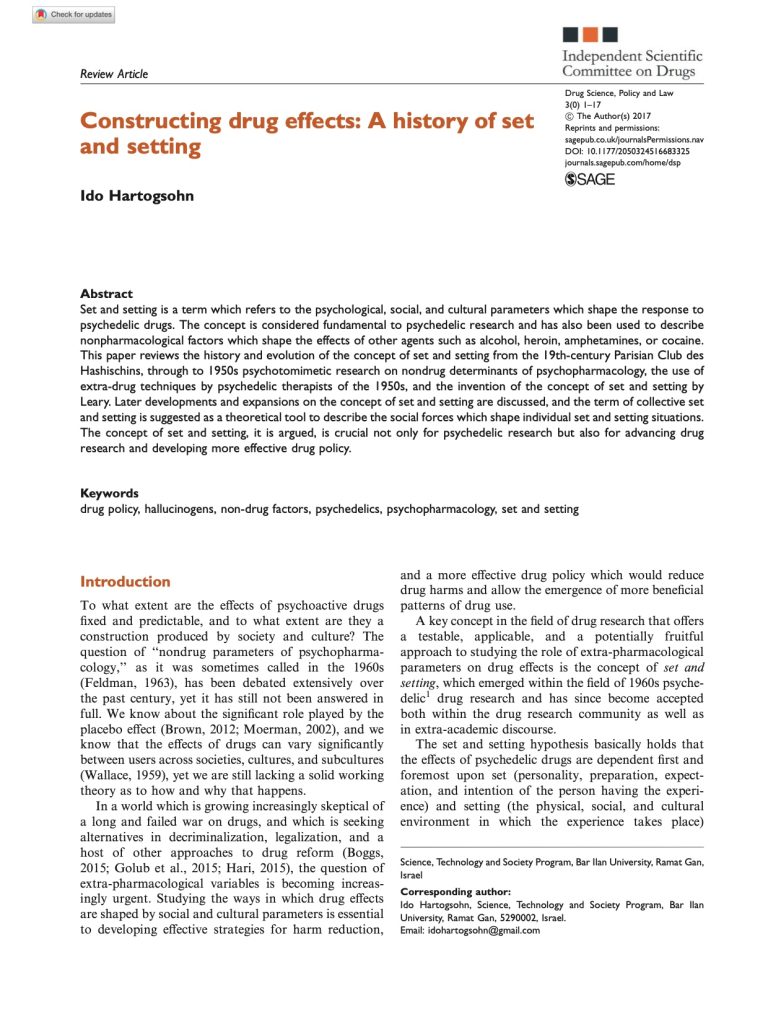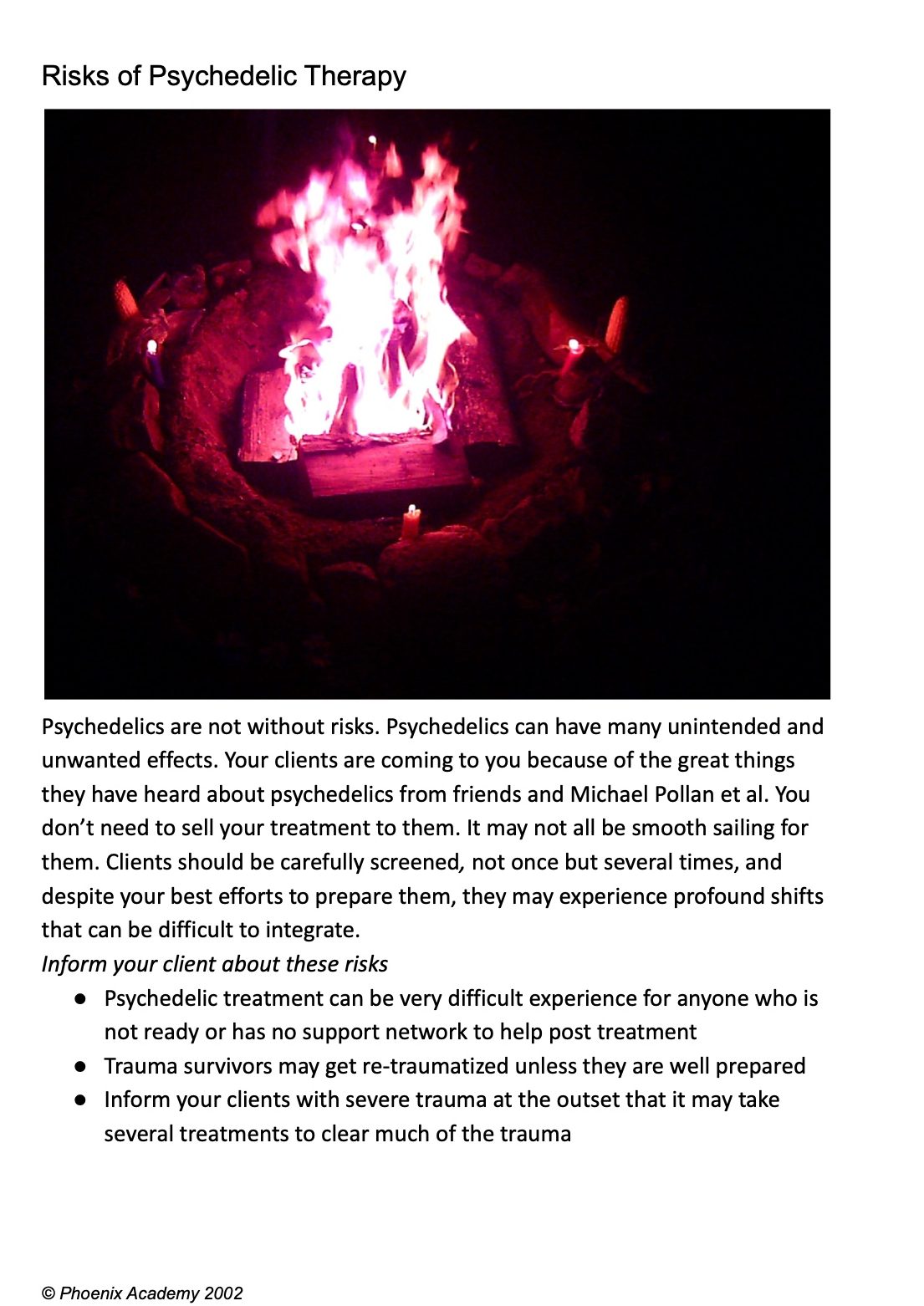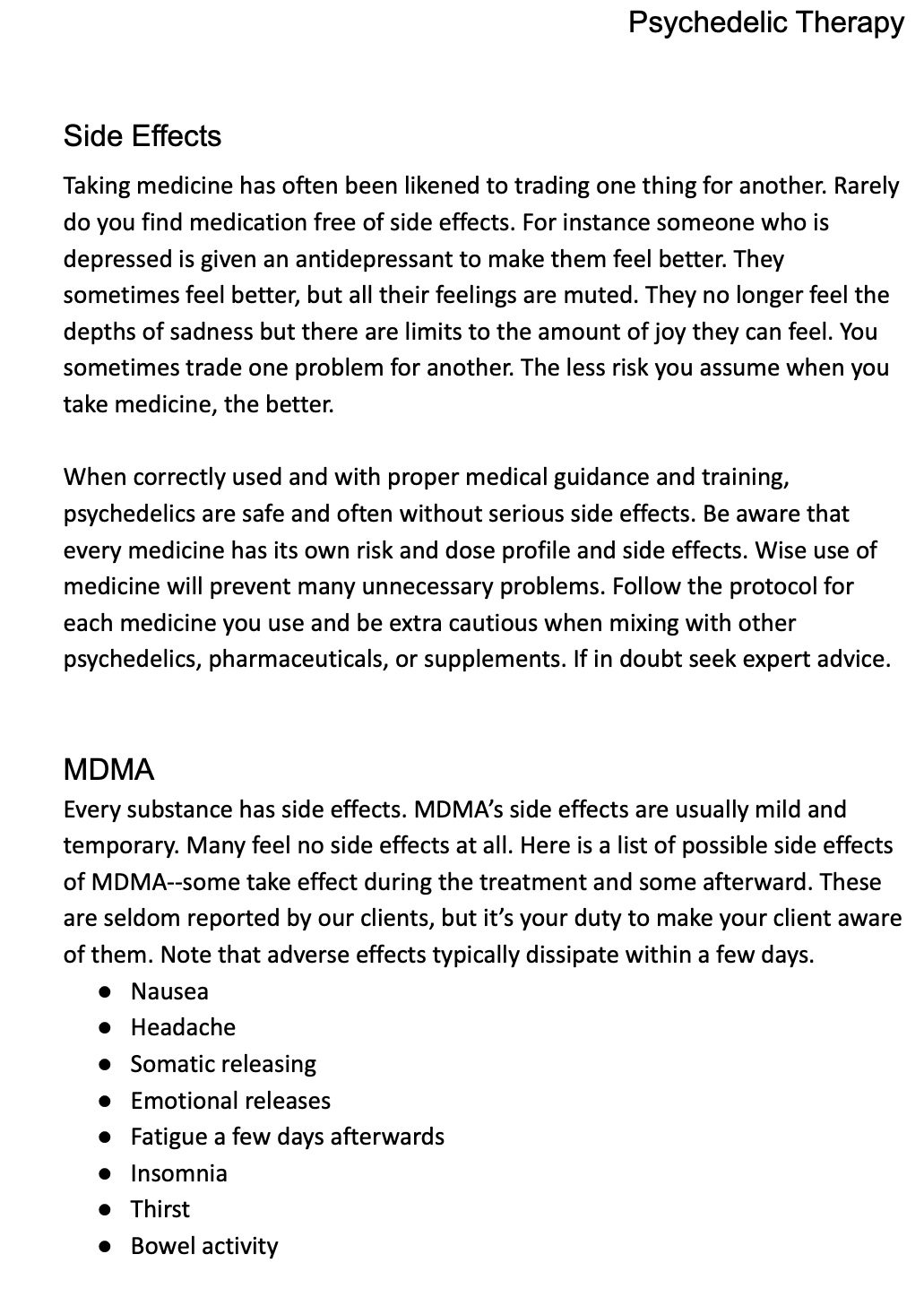To ensure the client is ready for treatment you must lay out the set and setting. When the aspects of set and setting are aligned, and your client is prepared, they are ready for treatment.
What is set and setting?
- The mindset and intention of your client
- The physical setting of the session
- The substance(s)
- The playlist/audio environment
- The mindset and intention of you and your co-therapist
- Your presence/intention
- Empowering the client – this is their journey
- Dropping expectations and surrendering
- The experience itself (ceremony, scents, etc.)
- The communities or cultures you and your client belong to
Read this article on the importance of set and setting by Ido Hartogsohn to gain some perspective of how and why set and setting has become recognized as such an important aspect of psychedelic therapy. It may help you to understand this somewhat intangible concept and your role in helping to ensure it works for your client.
Conducting a set and setting session
Review your client’s notes, questionnaire and intake prior to session.
Plan on a one hour session. Help clients find a meaningful intention to get to the core of their needs. Intention setting will be covered in greater detail in the workshop.
Have a discussion about the medicine you will use with this client
- Match it to their psychological profile and their intention. Discuss options if they are available: example, avoid giving psilocybin to highly anxious clients – Classic psychedelics are non-specific amplifiers. They may get to the root of their anxiety but it may be a traumatic journey.
- Discuss the medicines you work with. Avoid allowing the client to dictate what they take and how much. It may be their experience but you are being held responsible for the outcome. Use your judgement, experience, and intuition to match substances to your client and their intention.
- Discuss substance options for your client. Make them fully informed about what their experience might be like on each substance. If you plan to use a booster, frame it as option based on where the client is an hour or two into treatment.
- Always make it clear what substances and doses you will be giving your client. Never surprise your client in the treatment room with a substance you didn’t discuss with them.
- Discuss the pros and cons, and side effects of each substance
- Verify that they are not taking any pharmaceuticals or that they have tapered off as agreed.
- If on SSRIs or contraindicated substances, help your client establish a clear plan for tapering off and being clear for the recommended length of time before treatment. For SSRI, the period your client should be clear of them is at least 6 weeks for MDMA, 2 weeks for psilocybin
A Note about tapering off meds…
Tapering off pharmaceuticals like SSRIs can be brutal. Advise your client to seek the advice of a medical professional to assist them tapering off their meds. Often your client may not have a doctor or has one who is not supportive of tapering. To reduce harm, advise your client to slowly taper of their meds. Slow means reducing their dose no more than 10 – 25% a week and stopping if the side effects become too difficult.
We have found that once a client has tapered to a low dose of SSRI, microdosing can help smooth out the bumps.
Be cautious when dispensing medical advice. Make it clear you are not qualified to give such advice. You can provide examples that may help guide your clients, should they follow your cues. One way we can get into trouble is if the College of Physicians gets wind that you are “prescribing” medications or giving medical advice.
Discussion of the substance effects/ side effects
Always describe possible downsides of treatment with psychedelics:
- Treatment may adversely change your client’s priorities, perspective and relationships
- It may bring up unpleasant emotions that the client may not be ready to experience
- In rare instances, your client may feel worse after treatment.
- Without integration your client may lose the benefits of treatment
- Your client’s expectations for treatment are seldom attained
- Treatment can profoundly affect your client’s life both positively and negatively
- Spiritual emergency and or psychosis is a possibility which can have negative consequences is not handled carefully
- Unpleasant physical sensations may be experienced while processing emotions during the treatment or after.
- Clients with severe trauma or who are emotionally unstable may find that treatment will stir up things that have been successfully repressed
- Side effects vary with substance but are transitory. They include purging, headaches, low mood, lethargy, and fatigue
See Pros and Cons and side effects for a more complete list of topics
You seldom get what you expect, you always get what you need. Your intention will always be answered, often not how you expect.
Here’s a list of topics you should cover during set and setting:
- Show them the treatment room, allow them as much time as possible in there, or even better, hold the session in the room
- Be curious about your client’s current state and mindset
- Discuss their intention and be ready to challenge them to go deeper to uncover a more meaningful intention
- Discussion about the importance of integration – mention integration document you will send them
- What might integration look like for them?
- Explanation of integration using real examples
- Encourage them to plan how they will integrate their experience post treatment
- Engage them in a discussion about spirituality and talk about how psychedelics tend to make people more spiritually inclined.
- Talk about what to bring to treatment. Items may include photos of client as a child, parents when client was young, photos of siblings, children, extended family, and any items they deem significant such as stones, crystals, or momentos..
- Discuss the importance of bodywork/therapy pre and post treatment. It’s a good idea to have your client do bodywork as soon as possible after treatment. Provide a list of recommended body workers
- Discussion of consent to touch / body, energy work.
- Request permission to record audio of the session.
- Discuss the changes and discuss side effects they might experience post treatment.
- Probe to uncover any expectations or fears about the treatment that they may have
- Remind them to trust, surrender, and receive
- Discussion of playlist preferences/ options if you don’t have a standard playlist
- Set a treatment date
- Give them a clear idea of who may be sitting with them. Will they have an opportunity to meet your co-therapist before treatment?
- Tell them to expect calls from the team a few days before the treatment date
- Describe the nature of your follow up with client post treatment
- Remind them to be discreet about you and your practice when talking about their treatment
- Explain how you will protect their confidentiality
- Tell your client that you will be sending them documents on how to prepare for their treatment and post treatment integration
- Run through the treatment day practicalities including how to prepare for it:
- Diet and restrictions
- What to wear
- Have a quiet night before treatment and get a good sleep
- Time of arrival
- Duration of event
- Confirm treatment location
- Bring the donation in envelope
- How to mentally prepare for the day
- Bring mementos or personal items
- What to eat before and after
- Anticipated time of departure
- Book a bodywork session within a few days of treatment
- Mutual confidentiality – illegal activity – remind client of the importance of never using your name, profession, or location, or those of your co-therapists.
- Remind them to have someone pick them up or take a cab home. Do not allow them to drive after treatment
Send your client treatment and integration documents after the session.



The Ido Hartogsohn’s article was awesome. Thanks for providing this high-level knowledge.
Set and setting is what we bring to the treatment. It’s a manifestation of who we are!
I loved the article by Ido Hartogshon which was so rich in information! It’s importance can’t be stressed enough! Thank you for sharing it.
As a consent educator, I want to add that consent includes the whole process of sharing information with the client and coming to an agreement about set and setting, including substance, dosage, process, setting, confidentiality protocols, and interactions and contact before, during, and after the session.
It’s a common, and a limited view on consent to only think of it as applicable to touch.
Thank you so much for your perspective on the importance of comprehensive consent in a psychotherapeutic setting. We appreciate your expertise as a consent educator, and agree that consent is a multi-faceted process extending beyond just physical touch.
The informed consent process should indeed encompass a thorough understanding of all elements related to the session, such as the nature and purpose of the therapy, any interventions or techniques to be used, the potential risks and benefits, alternatives, privacy practices, pros and cons of various substances, and the client’s right to withdraw consent at any point.
We have focused on consent to touch as a key issue that often arises in ethics, law and public media. However, we recognize the importance of conveying the broader understanding of consent that you’ve outlined. If at the end of the course you consider the course should be modified, please let us know as we welcome your input.
I would like to add comments around indigenous use of psychotronic medicines that are based around centuries old traditions of set and setting. It was mentioned in Ido’s paper about this and how anglo folks had quite different experiences without the ceremony included. I hope to find much more research on this area as cultural misappropriation needs to be understood and connections made to the peoples who have been carrying medicines in some ways–so they are available to us now.